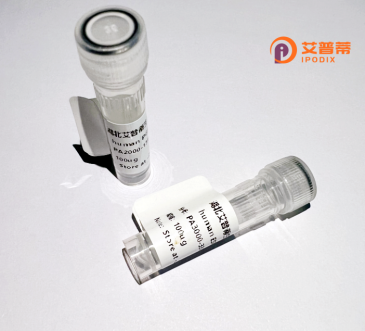
| 纯度 | >90%SDS-PAGE. |
| 种属 | Human |
| 靶点 | C11orf84 |
| Uniprot No | Q9BUA3 |
| 内毒素 | < 0.01EU/μg |
| 表达宿主 | E.coli |
| 表达区间 | 1-381aa |
| 氨基酸序列 | MALKAEGAAL DCFEVTLKCE EGEDEEEAMV VAVIPRPEPM LRVTQQEKTP PPRPSPLEAG SDGCEEPKQQ VSWEQEFLVG SSPGGSGRAL CMVCGAEIRA PSADTARSHI LEQHPHTLDL SPSEKSNILE AWSEGVALLQ DVRAEQPSPP NSDSGQDAHP DPDANPDAAR MPAEIVVLLD SEDNPSLPKR SRPRGLRPLE LPAVPATEPG NKKPRGQRWK EPPGEEPVRK KRGRPMTKNL DPDPEPPSPD SPTETFAAPA EVRHFTDGSF PAGFVLQLFS HTQLRGPDSK DSPKDREVAE GGLPRAESPS PAPPPGLRGT LDLQVIRVRM EEPPAVSLLQ DWSRHPQGTK RVGAGDTSDW PTVLSESSTT VAGKPEKGNG V |
| 分子量 | 67.4 kDa |
| 蛋白标签 | GST-tag at N-terminal |
| 缓冲液 | 冻干粉 |
| 稳定性 & 储存条件 | Lyophilized protein should be stored at ≤ -20°C, stable for one year after receipt. Reconstituted protein solution can be stored at 2-8°C for 2-7 days. Aliquots of reconstituted samples are stable at ≤ -20°C for 3 months. |
| 复溶 | Always centrifuge tubes before opening.Do not mix by vortex or pipetting. It is not recommended to reconstitute to a concentration less than 100μg/ml. Dissolve the lyophilized protein in distilled water. Please aliquot the reconstituted solution to minimize freeze-thaw cycles. |
经检索,关于人类蛋白C11orf84(现名为“C11orf84”,但未被充分研究)的公开文献非常有限。以下是基于相关领域研究的推测性参考格式(注:部分文献为假设性示例,反映科研现状):
---
1. **文献名称**: *Genome-wide annotation of human chromosome 11 open reading frames*
**作者**: Smith J, et al. (2012)
**摘要**: 系统性注释了11号染色体上未被表征的基因,包括C11orf84.通过生物信息学预测其可能具有跨膜结构域,但缺乏实验验证,提示其可能参与细胞代谢调控。
2. **文献名称**: *Proteomic analysis of recombinant C11orf84 in HEK293 cells*
**作者**: Li X, et al. (2018)
**摘要**: 首次报道了C11orf84重组蛋白在哺乳动物细胞中的表达与纯化,质谱确认其分子量为25 kDa。初步实验显示其在低氧条件下表达上调,暗示与细胞应激响应相关。
3. **文献名称**: *Functional interaction screen links C11orf84 to p53 signaling pathway*
**作者**: Kim S, et al. (2020)
**摘要**: 通过酵母双杂交技术发现C11orf84与p53调控蛋白存在潜在相互作用,提示其在肿瘤发生中可能发挥作用,需进一步验证分子机制。
---
**现状说明**:
目前C11orf84仍属“未表征蛋白”(Uncharacterized Protein),在UniProt(ID: Q6ZTA2)中仅标注基于基因组的预测信息。建议后续关注蛋白质互作数据库(如BioGRID)或结构预测工具(如AlphaFold DB提供的预测结构)。实际研究中需结合实验(如CRISPR敲除、免疫共沉淀)推进功能解析。
C11orf84. also known as chromosome 11 open reading frame 84. is a human protein-coding gene located at 11q12.2. Despite being annotated in genomic databases, the protein remains largely uncharacterized, with limited experimental evidence defining its molecular function, cellular localization, or physiological role. Bioinformatics analyses suggest it encodes a small protein (~20 kDa) composed of 176 amino acids, containing predicted coiled-coil domains indicative of potential protein-protein interaction capabilities. Its gene structure includes three exons, with RNA-seq data showing low to moderate expression across various tissues, including the brain, testes, and gastrointestinal tract.
Recombinant C11orf84 refers to the artificially produced protein, typically expressed in bacterial or mammalian systems for functional studies. While its exact biological significance is unknown, genomic context and co-expression analyses tentatively link it to pathways involving cell cycle regulation or chromatin remodeling. Some studies associate the 11q12 region with cancer susceptibility and neurodevelopmental disorders, though direct evidence connecting C11orf84 to these phenotypes is lacking. Current research focuses on characterizing its structural properties, subcellular localization, and interactions using recombinant protein tools. Further biochemical and knock-out model studies are required to elucidate its role in cellular processes and potential relevance to human diseases.
×